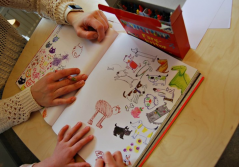Child abuse cases often lack corroborative evidence in the form of injuries, DNA or direct witness observations. Instead, the most important source of information about the alleged crime is typically the child’s testimony. A wide range of factors can influence children’s capability and willingness to disclose abuse during a police interview. Hence, the child interviewer needs to elicit reliable information from children without influencing their testimony. The National Institute of Child Health and Development (NICHD) protocol is a well-researched standardized method for interviewing children. Research shows that field training in the protocol can improve police interviewer skills, but some challenges remain. Revisions of the original protocol and other solutions may provide promise for cases where children are reluctant to talk. Recent technological advances also provide ways forward for research on child interviewing.
---
In August 1983, in a Californian suburb outside of Los Angeles, police started to investigate a child sexual abuse allegation. Little did they know that the McMartin case (State of California v. Buckey, 1990) would continue for nearly eight years and involve accusations from more than three hundred children. Seven preschool teachers were eventually accused of forcing preschoolers to participate in gruesome and bizarre sexual acts. Some of the children’s claims seemed highly improbable, such as that one of the accused could fly and that the preschool rested upon a network of underground tunnels. The California state prosecutors later dropped all charges but one important question remained – what caused so many children to report these apparently false claims?

Several factors, such as the use of highly suggestive questions and social pressure, were later identified in the McMartin case (Garven, Wood, Malpass, & Shaw, 1998). Although an extreme example, the case demonstrates some of the difficulties in play when interviewing young children in legal contexts. False details can be elicited by inadequate interviewing techniques and social influence. This can, in turn, lead to false allegations or even create entirely false memories of abuse (Loftus & Pickrell, 1995). Yes, you read right; memories can be implemented in your mind (there is a great TED Talk on this subject by Elizabeth Loftus). The legal consequences of false accusations can be devastating, as it could contribute to innocent people being convicted for crimes they did not commit. On the other hand, the proportion of false child sexual abuse allegations is estimated to be low, despite memorable miscarriages of justice such as the McMartin case. Trocmé and Bala (2005), for example, studied a large sample of Canadian abuse investigations and reported that only 2 - 6% of accusations concerning sexual abuse, maltreatment and neglect appeared to be intentionally fabricated. In fact, the widespread issue of underreporting is likely more of a problem, as a significant proportion of child victims experience great difficulties disclosing their victimization (e.g., London, Bruck, Wright, & Ceci, 2008).
Decades of laboratory and field research has demonstrated that children, even as young as three years of age, can provide accurate testimonies (e.g., Bruck & Ceci, 1999; Goodman & Melinder, 2007). But a wide range of factors influence children’s capability and willingness to report crimes to the police, and case studies of crimes that can be verified by other evidence (e.g., video-recordings) demonstrate that children often omit sensitive details or deny that the crime has taken place (e.g., Leander, 2010; Leander, Christianson, & Granhag, 2007; Sjöberg & Lindblad, 2002). In sexual abuse cases, trauma reactions, loyalty towards the perpetrator, and internal feelings of shame, guilt, and self-blame are just a few of the many barriers that could hinder a victim from sharing the details of their experience (e.g., Magnusson, Ernberg, & Landström, 2016). As the forensic child interview typically plays a central role during abuse investigations, a poorly conducted interview could have a direct negative effect on the legal outcome. This is particularly problematic in sexual abuse cases as corroborative physical evidence is often unavailable (Diesen & Diesen, 2009). Without a credible testimony, guilty perpetrators might be acquitted and children risk being sent back to an abusive environment (Ernberg, Tidefors & Landström, 2016). Additionally, other children may be targeted if the perpetrator reoffends. Conducting high quality interviews that adhere to current research on children’s witness capabilities is therefore a vital component for ensuring both children’s safety and a defendant’s right to a fair trial.
A heavy burden is consequently placed on the forensic child interviewer. They need to skilfully help victims talk at length about their experiences whilst avoiding the risk of eliciting false details. Simultaneously, they need to investigate if the report could be unfounded. Researchers and practitioners have therefore developed a number of evidence-based interviewing guidelines to help with this difficult task. In this article, we will take a closer look at one of the most commonly used research-based techniques for interviewing children; the National Institute of Child Health and Development (NICHD) protocol (Lamb, Orbach, Hershkowitz, Esplin, & Horowitz, 2007). Secondly, we discuss novel research programs and innovative tech-based solutions to improve the quality of forensic child interviewing. The future appears to hold a number of exciting new developments for the field.
The NICHD protocol is a concrete step-by-step guide for interviews with child sexual abuse victims (you can download the protocol at www.nichdprotocol.com). It has been translated into eleven different languages and implemented by law enforcement agencies (at national or district levels) in fourteen different countries (e.g., Canada, the USA, Japan, Israel, Finland, and Sweden; see La Rooy et al., 2015). In brief, the protocol divides the forensic child interview into three phases; the pre-substantive phase, the substantive phase and the closure phase (e.g., Lamb et al., 1996). The pre-substantive phase begins with an introduction (e.g., “My name is… and I work with the police”) and an explanation of ground rules (e.g., that the child should not try to guess and that it is okay to say “I don’t know” or “I don’t understand”). The pre-substantive phrase continues with a rapport building and interview practice stage where the interviewer tries to familiarize the child with the interview format (e.g., by asking the child about fun recent events). The purpose is to provide the child with practice in responding to the current type of questions, as the forensic child interview format differs from the way typical conversations are carried out. The interviewer thereafter transitions to the substantive phase of the interview by asking open-ended questions about the incident under investigation (e.g., “I understand that something has happened to you, tell me everything about that”) and encourages the child to elaborate (e.g., “Tell me more”). Specific questions (e.g., “Did he do something to you?”) should be postponed as long as possible and suggestive or leading questions (e.g., “Did he hit you?”) avoided completely. Prior to ending the interview, the interviewer is encouraged to ask questions about the child’s previous disclosure of the crime (e.g., “Have you talked to anyone else about this?”). This is followed by the closure phase, where the child is thanked for their cooperation and asked questions about a neutral topic for a few minutes (e.g., “What are you going to do this afternoon?”). The setup for training in the NICHD protocol varies between countries, but police officers typically undergo a five-day field training course in which officers participate in both active training workshops (e.g., role playing child interviews) and lectures on child development and investigative interviewing (Lamb et al., 2008).
Can NICHD training improve police interviewer skills?
Researchers have measured whether police officers’ interview skills improve after NICHD field training by examining the type of questions used in real forensic child interviews before and after training. Questions are typically classified into four different categories. For example, imagine that an interviewer wanted to acquire information about the colour of a toy dinosaur. He or she could use: (1) Invitations (e.g., “Tell me more about the dinosaur…”), (2) Directive questions (e.g., “What colour was the dinosaur?”) (3) Option-posing questions (e.g., “Was the dinosaur blue or pink?”) and (4) Suggestive questions (e.g., “The dinosaur was pink, wasn’t it?”) (see Lamb et al., 1996). Laboratory studies have demonstrated that invitations and directive questions are associated with more detailed and accurate responses from children (e.g., Bruck & Ceci, 1999) and are therefore seen as preferable to option-posing or suggestive questions.
Invitations and directive questions may improve accuracy because these question types draw primarily on recall-based memory processes. That is, the questions encourage the child to actively search and retrieve information from their memory, without any cues. Option-posing and suggestive questions, on the other hand, can activate recognition-based memory processes. That is, the questions encourage the child to search for memories that match the informational cues provided by the interviewer. Hence, there is an increased risk that children agree with inaccurate information because it feels familiar or partially matches their experience. Option-posing and suggestive questions also elicit more response bias (Lamb et al., 2007), meaning that children may formulate their answers with the intention of pleasing the interviewer or meeting expectations. For instance, young children tend to agree with suggestive questions even when the statement is incorrect, or try to guess the answer to an option-posing question that they do not know the correct answer to (e.g., Bruck & Ceci, 1999).
An impressive number of field studies involving more than 40 000 alleged crime victims have been conducted on the NICHD protocol. Taken together, the literature strongly suggests that NICHD training programs can help improve interviewers’ skills to better adhere with best-practice guidelines (Lamb et al., 2008). Many studies have reported significant increases in the amount of recall-based questions used by police officers after training (e.g., Cyr & Lamb, 2009; Lamb et al., 2009; Cederborg, Alm, da Silva Nises, & Lamb, 2013). Although option-posing and suggestive questions still occur, there is often noticeable decreases in their frequency. This is certainly promising. However, one critique of this research is that many studies exclude post-training interviews that do not follow the guidelines in the NICHD protocol (Benia, Hauck-Filho, Dillenburg, & Stein, 2015). The underlying rationale behind this choice is to examine effects of training if the protocol has been properly implemented (Lamb et al., 2008). Nonetheless, trainees do not always follow the protocol. In some cases, individual differences between police officers may explain why trainees do not adhere to the best-practice guidelines taught during training (Lafontaine & Cyr, 2016). Contextual factors might also influence the applicability of the protocol. For example, a child might start to talk about the crime allegation before the interviewer has explained the ground rules and practiced the interview format, thus warranting the interviewer to divert from the order of the protocol (Lamb et al., 2008).
 Providing officers with feedback after field training may also impact the long-term effectiveness of the training. An early study by Lamb, Sternberg, Orbach, Esplin, and Mitchell (2002a) examined the role of supervision after NICHD training among eight American police officers, and found that monthly individual feedback sessions on field interviews were necessary to maintain the positive effects of training. The authors argued that trainees appeared to fall back into old habits if not supervised regularly. Cyr, Dion, McDuff and Trotier-Sylvain (2012) tested this hypothesis by either giving feedback or no feedback to Canadian police investigators who had previously undergone a weeklong intensive training course. The analysis showed that the interviewers who received feedback used more invitations in their questioning, compared to interviewers who received no feedback. Lamb et al. (2002b) also found that feedback, either from individual evaluations or group discussions, did improve interviewing skills compared to investigators who only received theoretical lectures on child development. Hence, being evaluated and receiving comments on their interviewing performance may be important to maximize the effectiveness of field training on the NICHD protocol.
Providing officers with feedback after field training may also impact the long-term effectiveness of the training. An early study by Lamb, Sternberg, Orbach, Esplin, and Mitchell (2002a) examined the role of supervision after NICHD training among eight American police officers, and found that monthly individual feedback sessions on field interviews were necessary to maintain the positive effects of training. The authors argued that trainees appeared to fall back into old habits if not supervised regularly. Cyr, Dion, McDuff and Trotier-Sylvain (2012) tested this hypothesis by either giving feedback or no feedback to Canadian police investigators who had previously undergone a weeklong intensive training course. The analysis showed that the interviewers who received feedback used more invitations in their questioning, compared to interviewers who received no feedback. Lamb et al. (2002b) also found that feedback, either from individual evaluations or group discussions, did improve interviewing skills compared to investigators who only received theoretical lectures on child development. Hence, being evaluated and receiving comments on their interviewing performance may be important to maximize the effectiveness of field training on the NICHD protocol.
Does use of the NICHD protocol affect children's testimony?
So far this paper has focused on how training influences police officers’ behaviour. The following section will discuss how use of the NICHD protocol can affect the interview outcome in terms of the children’s testimony. The results of this research have varied. Cyr and Lamb (2009) found an overall increase in the number of details provided by children when officers followed the NICHD protocol, compared to children’s responses in interviews conducted before NICHD training. Most importantly, they reported an increase in the number of details of central value for the investigation, such as information about the perpetrator's identity and the type of abuse. Other studies have not found an overall increase in the amount of details, but have found that after NICHD training, when officers do elicit information from children, it is more often in response to invitations (e.g., “Tell me more about this”) rather than other types of questions (e.g., Lamb et al., 2009; Cyr et al., 2012). Given that responses to invitations (compared to recognition-based question types) tend to be more reliable and accurate, this is a promising finding. Some studies have also reported a decrease in the number of details that are provided when officers do use poor interview techniques, including option-posing and suggestive questions (e.g., Lamb et al., 2009; Lamb, Sternberg, Orbach, Hershkowitz, Horowitz, & Esplin, 2002b). This may be an effect of the pre-substantive phase of the NICHD protocol, where interviewers provide ground rules, such as encouraging children to avoid guessing and to check with the interviewer if they do not understand a question.
It appears that interviewing children using the NICHD protocol can improve certain aspects of children’s testimonies. However, it is difficult to assesses the actual accuracy of children’s responses using field research, since neither interviewers nor researchers have access to an objective account of the events being discussed in the interview. To fill this gap, some researchers have started to examine the NICHD technique in controlled laboratory settings. Brown, Lamb, Lewis, Pipe, Orbach, and Wolfman (2013), for example, studied effects of the NICHD interview practice phase as well as differences in children’s accuracy in response to different question types (i.e. invitations, directive, option-posing and suggestive questions) in an experiment with school-aged children. The children participated in a staged event where they had their photograph taken while wearing costumes. Some weeks later, they were interviewed by NICHD trained research assistants about this experience as well as about a fictitious visit to a fire station. The children were asked questions about the fire station visit to see if they would report false details (analogous to situations in which children might report false details of a crime). Overall, the children were highly accurate in their responses. Still, a small number of children (approximately 11%) provided false details about the non-existent fire station visit, demonstrating the risk of obtaining false testimonies when questioning children about events that have not occurred.
Taken together, existing research seems to provide evidence in favour of investing in NICHD training programs. Not only does training typically improve police interview skills to align with best-practice guidelines, it may elicit more and better information from children. To date, much of the research in this area has taken place in field settings, meaning that it typically does not provide the level of experimental control that would be possible in a laboratory setting. Controlled laboratory studies on police officers’ behaviour after training could contribute towards filling some of the gaps in existing research. Further studies also need to be carried out in order to compare the effectiveness of the NICHD protocol to other evidence-based interview protocols intended for use with child victims.
Future lines of inquiry
Revised versus standard NICHD protocol
Although often effective, the NICHD protocol is not a “one-size-fits-all” solution (Brown et al., 2013). In particular, eliciting details from children who are reluctant to talk can still be difficult (Hershkowitz, Orbach, Lamb, Sternberg & Horowitz, 2006). Hershkowitz and colleagues (2015) addressed this issue in a recent revision of the NICHD protocol. A larger focus was placed on building rapport between the child and interviewer. The revised NICHD protocol has an expanded pre-substantive stage, which includes an initial rapport building stage before the introduction of ground rules. For the substantive stage, the revised protocol emphasises the importance of acknowledging the child’s emotions (“I can see that you find this difficult to talk about”) and providing non-suggestive support throughout the interview (e.g., “Thank you for sharing this information with me”). You can read the revised protocol at www.nichdprotocol.com.
Initial studies on the revised protocol show promising results in terms of children’s responsiveness to questions compared to interviews with the standard protocol (Ahern, Hershkowitz, Lamb, Blasbalg, & Winstanley, 2014, Hershkowitz et al., 2015; Hershkowitz, Lamb, & Katz, 2014). Presumably, building rapport could help create the trust and support needed for reluctant victims to open up and disclose details about their abuse. Further laboratory studies are nonetheless needed to examine direct effects and underlying mechanisms of rapport building on disclosure tendencies in settings analogous to forensic child interviews (Saywitz, Larson, Hobbs, & Wells, 2015).
Technological advances in forensic child interview training
Technological advances have also led to new and promising lines of research on forensic child interviewing using the NICHD protocol or similar evidence-based techniques. Researchers at Åbo University in Finland are developing computer software that simulates interviews with young children (Pompedda, Zappalà, & Santtila, 2015). The aim is to provide police interviewers the opportunity to interact to animated child characters (called avatars) in a naturalistic digital environment. The avatars are pre-programmed with background stories that can involve sexual abuse, and the interviewer’s task is to investigate what happened to the avatar. The avatars are programmed with research-based algorithms that correspond to how children typically respond to questions. For example, using invitations and directive questions leads to more correct responses and suggestive questions may elicit false details from the avatars. Experimental studies of this training software have yielded promising results. Trainees have shown improvement in their use of appropriate question types after just one hour of training. In Sweden, researchers have examined a similar digital interview environment where instructors (expert interviewers) have manual control over the animated child characters in the program. (Johansson, 2015). The instructor plays the role of the child in real time and his or her answers are then directly projected into the program through an avatar. Thus, the trainee sees and hears an animated child respond to his or her question in realistic manner. While prototype development is still underway, preliminary results indicate this could be a beneficial approach to forensic child interview training.
In Australia, Benson and Powell (2015) investigated the effects of using interactive web based course modules in forensic child interviewing, where police officers can refresh their knowledge online. In both field interviews and mock interviews with actors, officers adhered more closely to research-based guidelines after the web-based training, compared to before. The concept of easily accessible web-based training seems particularly promising given that regular feedback seems to help police officers stay on track and maintain the new techniques learned in NICHD training (Lamb et al., 2002a). Advanced technology could thus offer an exciting new way forward for practitioners to improve and maintain their forensic child interview skills.
To conclude, the NICHD protocol has helped improve the quality of police interviews with children around the globe. New research continues to investigate techniques for interviewing children who are reluctant to talk. Given that disclosing abuse can be incredibly difficult and daunting for children, this is a hurdle of utmost importance to overcome. At the same time, researchers and practitioners need to keep in mind the flawed nature of human memory, and find ways to encourage disclosures without inadvertently encouraging inaccurate testimony or false memories.
References
Ahern, E. C., Hershkowitz, I., Lamb, M. E., Blasbalg, U., & Winstanley, A. (2014). Support and reluctance in the pre-substantive phase of alleged child abuse victim investigative interviews: Revised versus standard NICHD protocol. Behavioural Sciences & the Law, 32, 762-774. doi: 10.1002/bsl.2149
Benia, L. R., Hauck-Filho, N., Dillenburg, M., & Stein, L. M. (2015). The NICHD investigative interview protocol: A meta-analytic review. Journal of Child Sexual Abuse, 24, 259-279. doi: 10.1080/10538712.2015.1006749
Benson, M. S., & Powell, M. B. (2015). Evaluation of a comprehensive interactive training system for investigative interviewers of children. Psychology, Public Policy, and Law, 21, 309-322. doi: 10.1037/law0000052
Brown, D. A., Lamb, M. E., Lewis, C., Pipe, M., Orbach, Y., & Wolfman, M. (2013). The NICHD investigative interview protocol: An analogue study. Journal of Experimental Psychology: Applied, 19, 367-382. doi:10.1037/a0035143
Bruck, M., & Ceci, S. J. (1999). The suggestibility of children's memory. Annual Review of Psychology, 50, 419-439. doi: 10.1146/annurev.psych.50.1.419
Cederborg, A-C., Alm, C., da Silva Nises, D. L., & Lamb, M. E. (2013). Investigative interviewing of alleged child abuse victims: An evaluation of a new training programme for investigative interviewers. Police Practice and Research, 14, 242-254. doi: 10.1080/15614263.2012.712292.
Cyr, M., Dion, J., McDuff, P., & Trotier-Sylvain, K. (2012). Transfer of skills in the context of non-suggestive investigative interviews: Impact of structured interview protocol and feedback. Applied Cognitive Psychology, 26, 516-524. doi: 10.1002/acp.2822
Cyr, M., & Lamb, M. E. (2009). Assessing the effectiveness of the NICHD investigative interview protocol when interviewing French-speaking alleged victims of child sexual abuse in Quebec. Child Abuse and Neglect, 33, 257-268. doi: 10.1016/j.chiabu.2008.04.002
Diesen, C., & Diesen, E. F. (2009). Övergrepp mot kvinnor och barn: Den rättsliga hanteringen [Assault on women and children: The legal practice]. Stockholm: Norstedts Juridik.
Dion, J., & Cyr, M. (2008). The use of the NICHD protocol to enhance the quantity of details obtained from children with low verbal abilities in investigative interviews: A pilot study. Journal of Child Sexual Abuse, 17, 144-162. doi: 10.1080/10538710801916564
Ernberg, E., Tidefors, I., & Landström, S. (2016). Prosecutors’ reflections on sexually abused preschoolers and their ability to stand trial. Child Abuse & Neglect, 57, 21-29. doi: 10.1016/j.chiabu.2016.06.001
Garven, S., Wood, J. M., Malpass, R. S., & Shaw, J. S. III. (1998). More than suggestion: The effect of interviewing techniques from the McMartin preschool case. Journal of Applied Psychology, 83, 347-359.
Goodman, G. S., & Melinder, A. (2007). Child witness research and forensic interviews of young children: A review. Legal and Criminological Psychology, 12, 1-19. doi: 10.1348/135532506X156620
Hershkowitz, I., Lamb, M. E., & Katz, C. (2014). Allegation rates in forensic child abuse investigations: Comparing the revised and standard NICHD protocol. Psychology, Public Policy and Law, 3, 336-344. doi: 10.1037/aa0037391
Hershkowitz, I., Lamb, M. E., Katz, C., & Malloy, L. C. (2015). Does enhanced rapport-building alter the dynamics of investigative interviews with suspected victims of intra-familial abuse? Journal of Police and Criminal Psychology, 30, 6-14. doi: 10.1007/s11896-013-9136-8
Hershkowitz, I., Orbach, Y., Lamb, M. E., Sternberg, K. J., & Horowitz, D. (2006). Dynamics of forensic interviews with suspected abuse victims who do not disclose abuse. Child Abuse & Neglect, 30, 753-769. doi: 10.1016/j.chiabu.2005.10.016
Johansson, D. (2015). Design and evaluation of an avatar-mediated system for child interviewing training (Master’s thesis, Linnaeus University, Kalmar/Växjö, Sweden). Retrieved from http://www.diva-portal.org/smash/record.jsf?pid=diva2%3A787845&dswid=17…
Lafontaine, J., & Cyr, M. (2016). A study of the relationship between investigators’ personal characteristics and adherence to interview best practices in training. Psychiatry, Psychology and Law, 1-16. doi: 10.1080/13218719.2016.1152925
Lamb, M. E, Hershkowitz, I., Orbach, Y., & Esplin, P. W. (2008). Tell me what happened: Structured investigative interviews of child victims and witnesses. Chichester, UK: Wiley.
Lamb, M. E., Hershkowitz, I., Sternberg, K. J., Esplin, P. W., Hovav, M., … Yudilevitch, L. (1996). Effects of investigative utterance types of Israeli children's responses. International Journal of Behavioural Development, 19, 627-637. doi: 10.1080/016502595385721
Lamb, M. E., Orbach, Y., Hershkowitz, I., Esplin, P. W., & Horowitz, D. (2007). A structured forensic interview protocol improves the quality and informativeness of investigative interviews with children: A review of research using the NICHD investigative interview protocol. Child Abuse and Neglect, 31, 1201-1231. doi: 10.1016/j.chiabu.2007.03.021
Lamb, M. E., Orbach, Y., Sternberg, K. J., Aldrige, J., Pearson, S., … Bowler, L. (2009). Use of a structured investigative protocol enhances the quality of investigative interviews with alleged victims of child sexual abuse in Britain. Applied Cognitive Psychology, 23, 449-467. doi: 10.1002/acp.1489
Lamb, M. E., Sternberg, K. J., Orbach, Y., Esplin, P. W., & Mitchell, S. (2002a). Is ongoing feedback necessary to maintain the quality of investigative interviews with allegedly abused children? Applied Developmental Science, 6, 35-41. doi: 10.1207/S1532480XADS0601_04
Lamb, M. E., Sternberg, K. J., Orbach, Y., Hershkowitz, I., Horowitz, D., & Esplin, P. W. (2002b). The effects of intensive training and ongoing supervision on the quality of investigative interviews with alleged sex abuse victims. Applied Developmental Science, 6, 114-125. doi: 10.1207/S1532480XADS0603_2
La Rooy, D., Brubacher, S. P., Aromäki-Stratos, A., Cyr, M., Hershkowitz, I., Korkman, J., … Lamb, M. E. (2015). The NICHD protocol: A review of an internationally-used evidence-based tool for training child forensic interviewers. Journal of Criminological Research, Policy and Practice, 1, 76-89. doi: 10.1108/JCRPP-01-2015-0001
Leander, L. (2010). Police interviews with child sexual abuse victims: Patterns of reporting, avoidance and denial. Child Abuse & Neglect, 34, 192-205. doi: 10.1016/j.chiabu.2009.09.011
Leander, L., Christianson, S. Å., & Granhag, P. A. (2007). A sexual abuse case study: Children’s memories and reports. Psychiatry, Psychology and Law, 14, 120-129. doi: 10.1375/pplt.14.1.120
Loftus, E. F., & Pickrell, J. E. (1995). The formation of false memories. Psychiatric Annals, 25, 720.725.
London, K., Bruck, M., Wright, D. B., & Ceci, S. J. (2008). Review of the contemporary literature on how children report sexual abuse to others: Findings, methodological issues, and implications for forensic interviewers. Memory, 16, 29-47. doi: 10.1080/09658210701725732
Magnusson, M., Ernberg, E., & Landström, S. (2016). Preschoolers' disclosures of child sexual abuse: Examining corroborated cases from Swedish Courts. Manuscript in preparation.
Pompedda, F., Zappalà, A., & Santtila, P. (2015). Simulations of child sexual abuse interviews using avatars paired with feedback improves interview quality. Psychology, Crime & Law, 21, 28-52. doi: 10.1080/1068316X.2014.915323
Saywitz, K. J., Larson, R. P., Hobbs, S., & Wells, C. R. (2015). Developing rapport with children in forensic interviews: systematic review of experimental research. Behavioural Sciences and the Law, 33, 372-389. doi: 10.1002/bsl.2186
Sjöberg, R. F., & Lindblad, F. (2002). Limited disclosure of sexual abuse in children whose experiences were documented by videotape. American Journal of Psychiatry, 158, 312-314. doi: 10.1176/appi.ajp.159.2.312
Trocmé, N., & Bala, N. (2005). False allegations of abuse and neglect when parents separate. Child Abuse & Neglect, 29, 1333-1345. doi: 10.1016/j.chiabu.2004.06.016



